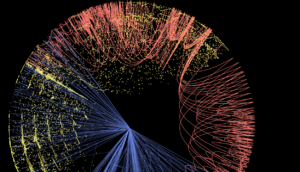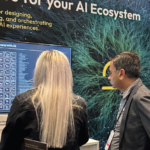
post
October 31, 2023
The Critical Components of Organizational AGI
Gartner’s IT Symposium is always a welcome opportunity to engage with the community of technology leaders. The recent explosion of generative AI technology has pushed that community to grow significantly since last year’s Symposium. There was much to discuss, and the conversations we had over the course of four days in Orlando made it clear that enterprises are getting far more serious about leveraging AI and conversational software interfaces in more substantial ways.
“GenAI is not just a technology or just a business trend. It is a profound shift in how humans and machines interact,” Gartner’s Distinguished VP Analyst Mary Mesaglio said in the opening keynote. “We are moving from what machines can do for us to what machines can be for us. Machines are evolving from being our tools to becoming our teammates. Gartner predicts that by 2025, GenAI will be a workforce partner for 90% of companies worldwide.”
We call these digital teammates Intelligent Digital Workers (IDWs) and we’re already seeing our customers and partners use them to organize and summarize information, mediate human communications, personalize scheduling, allocate resources, and complete tasks that are considered mundane.
This kind of assistance has proven game-changing for our enterprise partners, but it’s really just the beginning. These are early use cases that can be improved, built upon, and recombined with other automations to massive effect. Success here requires a foundational ecosystem that combines the technologies associated with conversational and generative AI, along with legacy technology and all types of organizational data. This ecosystem functions as an interactive digital twin of an organization. In essence, this is organizational AGI, a twin that “knows” everything an org knows and can be interacted with and programmed in an infinite number of ways.
In the opening keynote, Mesaglio was joined by fellow VP analyst Don Scheibenreif, who added, “More and more AI will be jointly delivered by IT and the wider enterprise. To succeed, the whole executive team must be engaged. This provides a tremendous opportunity for CIOs to make a difference.”
In my Symposium presentation, “Point Solutions vs. Platforms,” I talked about the five critical components of an ecosystem for properly leveraging generative AI. IDWs are one of these critical pieces, but they require some specific strategic initiatives and infrastructure that CIOs can green-light, champion, and implement. In our world, these take the form of an intelligent communication fabric, a contextual memory system, and a cognitive orchestration engine.
If you want learn more about these elements of organizational AI, our co-founder and CEO Robb Wilson put together a great resource titled, “Generative AI, Point Solutions, Platforms, and Hyperglue.” (If you weren’t able to pick up a physical copy at the Symposium, you can download a copy here.) As co-author of the first bestselling book about conversational AI, Robb’s thinking has been readily adopted by business leaders all over the globe. Our entire team at OneReach.ai is committed to sharing knowledge about these powerful technologies.
If we had a chance to chat at IT Symposium, let’s continue the conversation. If this is your first encounter with our platform and strategy, drop us a line. We’d love to connect.
Stay up to date
Latest Articles




